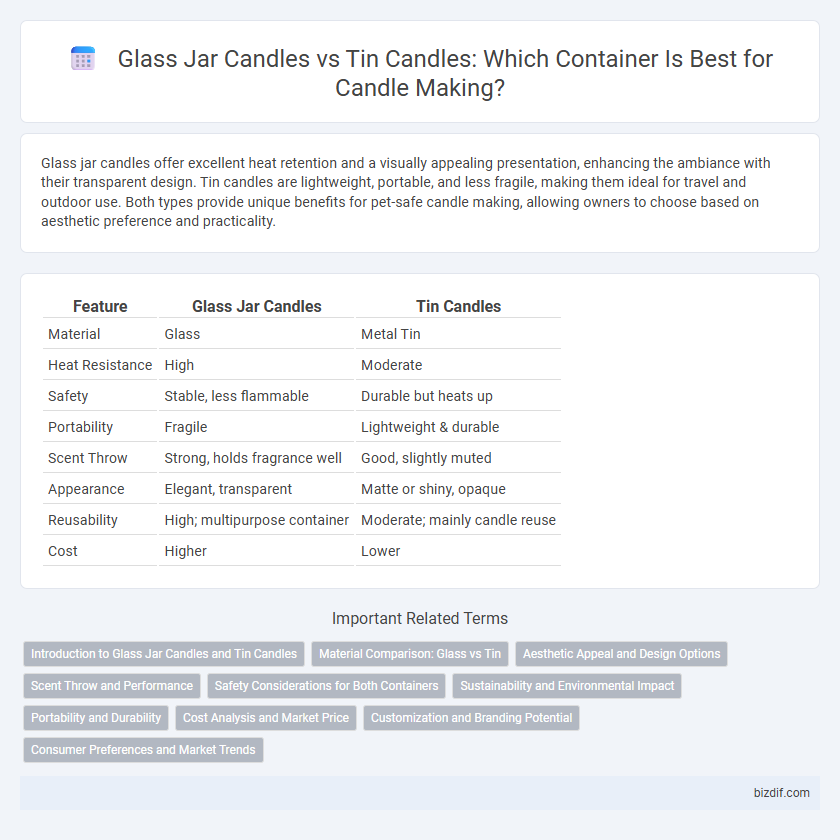Glass jar candles offer excellent heat retention and a visually appealing presentation, enhancing the ambiance with their transparent design. Tin candles are lightweight, portable, and less fragile, making them ideal for travel and outdoor use. Both types provide unique benefits for pet-safe candle making, allowing owners to choose based on aesthetic preference and practicality.
Table of Comparison
| Feature | Glass Jar Candles | Tin Candles |
|---|---|---|
| Material | Glass | Metal Tin |
| Heat Resistance | High | Moderate |
| Safety | Stable, less flammable | Durable but heats up |
| Portability | Fragile | Lightweight & durable |
| Scent Throw | Strong, holds fragrance well | Good, slightly muted |
| Appearance | Elegant, transparent | Matte or shiny, opaque |
| Reusability | High; multipurpose container | Moderate; mainly candle reuse |
| Cost | Higher | Lower |
Introduction to Glass Jar Candles and Tin Candles
Glass jar candles offer a classic aesthetic with transparency that showcases the wax color, enhancing decorative appeal while providing sturdy containment for even burning. Tin candles are lightweight, portable, and often more durable due to their metal casing, making them ideal for travel or outdoor use without the risk of breaking. Both types feature heat-resistant properties but differ in heat retention, with glass jars maintaining warmth longer and tins cooling more quickly after extinguishing.
Material Comparison: Glass vs Tin
Glass jar candles offer excellent heat resistance and a transparent aesthetic that showcases the candle's color and flickering flame, enhancing ambiance. Tin candles provide superior durability and portability, being lightweight and less prone to breaking, ideal for travel or outdoor use. Glass retains fragrance oils well, promoting even burning, while tin containers often disperse heat faster, potentially affecting burn time and scent throw.
Aesthetic Appeal and Design Options
Glass jar candles offer a clear, elegant presentation that showcases the candle's color and texture, making them ideal for sophisticated decor and customizable label designs. Tin candles provide a sleek, modern look with a variety of matte and metallic finishes, appealing to minimalist and rustic styles while offering compact, travel-friendly options. Both options support diverse design elements, but glass jars emphasize visibility and refinement, whereas tins emphasize portability and contemporary aesthetics.
Scent Throw and Performance
Glass jar candles typically offer a stronger scent throw and longer burn time due to their heat-resistant properties, which allow the wax to melt evenly and release fragrance consistently. Tin candles, while more portable and durable, often have a milder scent throw because the metal container dissipates heat faster, impacting the wax's ability to fully release its fragrance. Choosing between glass jar and tin candles depends on whether scent intensity or convenience and durability is prioritized in candle performance.
Safety Considerations for Both Containers
Glass jar candles provide a sturdy, heat-resistant container that minimizes the risk of melting and reduces fire hazards when used properly, while ensuring the flame is safely enclosed. Tin candles offer lightweight, portable options with high durability, but require sufficient ventilation to prevent overheating and potential tin warping. Both containers demand use on stable surfaces away from flammable materials, with appropriate wick sizing to maintain controlled burn safety.
Sustainability and Environmental Impact
Glass jar candles offer superior sustainability due to their recyclability and durability, reducing waste and environmental footprint compared to tin candles. Tin containers often come with coatings or mixed metals that complicate recycling, leading to increased landfill contributions. Selecting glass jars sourced from recycled materials enhances eco-friendliness in candle making by minimizing resource consumption and supporting circular economy practices.
Portability and Durability
Glass jar candles offer a classic aesthetic but are heavier and fragile, making them less portable and prone to breakage during travel. Tin candles provide enhanced durability with their metal casing, resisting dents and cracks, which makes them ideal for on-the-go use or outdoor settings. The lightweight nature and sturdy construction of tin candles ensure better portability without compromising safety.
Cost Analysis and Market Price
Glass jar candles generally have higher production costs due to thicker materials and more elaborate designs, resulting in retail prices ranging from $15 to $30 per unit. Tin candles, made from lightweight, inexpensive metal, tend to be more cost-effective with production costs significantly lower, allowing market prices between $8 and $18. The cost analysis indicates that while glass jar candles offer premium aesthetics, tin candles provide budget-friendly options appealing to price-sensitive consumers.
Customization and Branding Potential
Glass jar candles offer superior customization options with a wide range of shapes, sizes, and label designs that enhance brand visibility and appeal. Tin candles provide a compact, durable alternative, ideal for mobile branding and cost-effective bulk production but offer fewer styling variations. Brands seeking premium presentation and intricate label work often prefer glass jars, while those targeting portability and budget-friendly options opt for tins.
Consumer Preferences and Market Trends
Glass jar candles offer a premium aesthetic with enhanced scent diffusion, appealing to consumers seeking a decorative and long-lasting candle experience. Tin candles provide portability and durability, attracting eco-conscious buyers favoring lightweight and reusable packaging. Market trends indicate a growing demand for sustainable materials and versatile designs, with glass jars leading in home decor appeal while tins dominate travel-friendly and outdoor candle segments.
Glass Jar Candles vs Tin Candles Infographic

 bizdif.com
bizdif.com